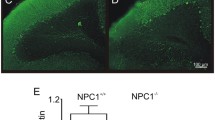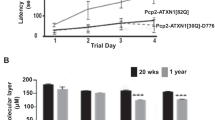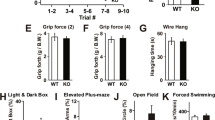Abstract
In cerebellar Purkinje cells, the β4-subunit of voltage-dependent Na+ channels has been proposed to serve as an open-channel blocker giving rise to a “resurgent” Na+ current (I NaR) upon membrane repolarization. Notably, the β4-subunit was recently identified as a novel substrate of the β-secretase, BACE1, a key enzyme of the amyloidogenic pathway in Alzheimer's disease. Here, we asked whether BACE1-mediated cleavage of β4-subunit has an impact on I NaR and, consequently, on the firing properties of Purkinje cells. In cerebellar tissue of BACE1−/− mice, mRNA levels of Na+ channel α-subunits 1.1, 1.2, and 1.6 and of β-subunits 1–4 remained unchanged, but processing of β4 peptide was profoundly altered. Patch-clamp recordings from acutely isolated Purkinje cells of BACE1−/− and WT mice did not reveal any differences in steady-state properties and in current densities of transient, persistent, and resurgent Na+ currents. However, I NaR was found to decay significantly faster in BACE1-deficient Purkinje cells than in WT cells. In modeling studies, the altered time course of I NaR decay could be replicated when we decreased the efficiency of open-channel block. In current-clamp recordings, BACE1−/− Purkinje cells displayed lower spontaneous firing rate than normal cells. Computer simulations supported the hypothesis that the accelerated decay kinetics of I NaR are responsible for the slower firing rate. Our study elucidates a novel function of BACE1 in the regulation of neuronal excitability that serves to tune the firing pattern of Purkinje cells and presumably other neurons endowed with I NaR.









Similar content being viewed by others
Abbreviations
- ACSF:
-
Artificial cerebrospinal fluid
- AD:
-
Alzheimer's disease
- ADP:
-
Afterdepolarization
- BACE1:
-
β-site APP (amyloid precursor protein)-cleaving enzyme 1
- CTF:
-
C-terminal fragment
- DRG:
-
Dorsal root ganglion
- ICD:
-
Intracellular domain
- FL:
-
Full-length
- I Na :
-
Fast Na+ current
- I NaP :
-
Persistent Na+ current
- I NaR :
-
Resurgent Na+ current
- WT:
-
Wild type
References
Afshari FS, Ptak K, Khaliq ZM, Grieco TM, Slater NT, McCrimmon DR, Raman IM (2004) Resurgent Na currents in four classes of neurons of the cerebellum. J Neurophysiol 92:2831–2843
Akemann W, Knopfel T (2006) Interaction of Kv3 potassium channels and resurgent sodium current influences the rate of spontaneous firing of Purkinje neurons. J Neurosci 26:4602–4612
Aman TK, Raman IM (2007) Subunit dependence of Na channel slow inactivation and open channel block in cerebellar neurons. Biophys J 92:1938–1951
Aman TK, Grieco-Calub TM, Chen C, Rusconi R, Slat EA, Isom LL, Raman IM (2009) Regulation of persistent Na current by interactions between beta subunits of voltage-gated Na channels. J Neurosci 29:2027–2042
Bant JS, Raman IM (2010) Control of transient, resurgent, and persistent current by open-channel block by Na channel beta4 in cultured cerebellar granule neurons. Proc Natl Acad Sci USA 107:12357–12362
Bean BP (2007) The action potential in mammalian central neurons. Nat Rev Neurosci 8:451–465
Brackenbury WJ, Calhoun JD, Chen C, Miyazaki H, Nukina N, Oyama F, Ranscht B, Isom LL (2010) Functional reciprocity between Na+ channel Nav1.6 and beta1 subunits in the coordinated regulation of excitability and neurite outgrowth. Proc Natl Acad Sci USA 107:2283–2288
Castelli L, Nigro MJ, Magistretti J (2007) Analysis of resurgent sodium-current expression in rat parahippocampal cortices and hippocampal formation. Brain Res 1163:44–55
Catterall WA (2000) From ionic currents to molecular mechanisms: the structure and function of voltage-gated sodium channels. Neuron 26:13–25
Chen Y, Yu FH, Sharp EM, Beacham D, Scheuer T, Catterall WA (2008) Functional properties and differential neuromodulation of Na(v)1.6 channels. Mol Cell Neurosci 38:607–615
Cole SL, Vassar R (2007) The basic biology of BACE1: a key therapeutic target for Alzheimer's disease. Curr Genomics 8:509–530
Cole SL, Vassar R (2008) The role of amyloid precursor protein processing by BACE1, the beta-secretase, in Alzheimer disease pathophysiology. J Biol Chem 283:29621–29625
Dominguez D, Tournoy J, Hartmann D, Huth T, Cryns K, Deforce S, Serneels L, Camacho IE, Marjaux E, Craessaerts K, Roebroek AJ, Schwake M, D’Hooge R, Bach P, Kalinke U, Moechars D, Alzheimer C, Reiss K, Saftig P, De SB (2005) Phenotypic and biochemical analyses of BACE1- and BACE2-deficient mice. J Biol Chem 280:30797–30806
Fry M (2006) Developmental expression of Na+ currents in mouse Purkinje neurons. Eur J Neurosci 24:2557–2566
Grieco TM, Malhotra JD, Chen C, Isom LL, Raman IM (2005) Open-channel block by the cytoplasmic tail of sodium channel beta4 as a mechanism for resurgent sodium current. Neuron JT - Neuron 45:233–244
Hines ML, Carnevale NT (1997) The NEURON simulation environment. Neural Comput 9:1179–1209
Hitt BD, Jaramillo TC, Chetkovich DM, Vassar R (2010) BACE1−/− mice exhibit seizure activity that does not correlate with sodium channel level or axonal localization. Mol Neurodegener 5:31
Holt GR, Softky WR, Koch C, Douglas RJ (1996) Comparison of discharge variability in vitro and in vivo in cat visual cortex neurons. J Neurophysiol 75:1806–1814
Hu X, Zhou X, He W, Yang J, Xiong W, Wong P, Wilson CG, Yan R (2010) BACE1 deficiency causes altered neuronal activity and neurodegeneration. J Neurosci 30:8819–8829
Huth T, Schmidt-Neuenfeldt K, Rittger A, Saftig P, Reiss K, Alzheimer C (2009) Non-proteolytic effect of beta-site APP-cleaving enzyme 1 (BACE1) on sodium channel function. Neurobiol Dis 33:282–289
Jarecki BW, Piekarz AD, Jackson JO, Cummins TR (2010) Human voltage-gated sodium channel mutations that cause inherited neuronal and muscle channelopathies increase resurgent sodium currents. J Clin Invest 120:369–378
Khaliq ZM, Gouwens NW, Raman IM (2003) The contribution of resurgent sodium current to high-frequency firing in Purkinje neurons: an experimental and modeling study. J Neurosci 23:4899–4912
Kim DY, Carey BW, Wang H, Ingano LA, Binshtok AM, Wertz MH, Pettingell WH, He P, Lee VM, Woolf CJ, Kovacs DM (2007) BACE1 regulates voltage-gated sodium channels and neuronal activity. Nat Cell Biol 9:755–764
Kuo CC, Bean BP (1994) Na+ channels must deactivate to recover from inactivation. Neuron 12:819–829
Raman IM, Bean BP (1997) Resurgent sodium current and action potential formation in dissociated cerebellar Purkinje neurons. J Neurosci 17:4517–4526
Raman IM, Bean BP (1999) Ionic currents underlying spontaneous action potentials in isolated cerebellar Purkinje neurons. J Neurosci 19:1663–1674
Raman IM, Bean BP (2001) Inactivation and recovery of sodium currents in cerebellar Purkinje neurons: evidence for two mechanisms. Biophys J 80:729–737
Raman IM, Sprunger LK, Meisler MH, Bean BP (1997) Altered subthreshold sodium currents and disrupted firing patterns in Purkinje neurons of Scn8a mutant mice. Neuron 19:881–891
Swensen AM, Bean BP (2003) Ionic mechanisms of burst firing in dissociated Purkinje neurons. J Neurosci 23:9650–9663
Wong HK, Sakurai T, Oyama F, Kaneko K, Wada K, Miyazaki H, Kurosawa M, De SB, Saftig P, Nukina N (2005) Beta Subunits of voltage-gated sodium channels are novel substrates of beta-site amyloid precursor protein-cleaving enzyme (BACE1) and gamma-secretase. J Biol Chem 280:23009–23017
Yu FH, Westenbroek RE, Silos-Santiago I, McCormick KA, Lawson D, Ge P, Ferriera H, Lilly J, DiStefano PS, Catterall WA, Scheuer T, Curtis R (2003) Sodium channel beta4, a new disulfide-linked auxiliary subunit with similarity to beta2. J Neurosci 23:7577–7585
Acknowledgements
We are grateful to K. Kronenbitter and D. Gremelle for their technical assistance. This work was supported by the Deutsche Forschungsgemeinschaft (P.S., C.A.), the University of Kiel (C.A.), the Interuniversity Attraction Poles Program P5/19 of the Belgian Federal Science Policy Office (P.S.), and the Center of Excellence “Inflammation at Interfaces” (P.S.).
Author information
Authors and Affiliations
Corresponding author
Rights and permissions
About this article
Cite this article
Huth, T., Rittger, A., Saftig, P. et al. β-Site APP-cleaving enzyme 1 (BACE1) cleaves cerebellar Na+ channel β4-subunit and promotes Purkinje cell firing by slowing the decay of resurgent Na+ current. Pflugers Arch - Eur J Physiol 461, 355–371 (2011). https://doi.org/10.1007/s00424-010-0913-2
Received:
Revised:
Accepted:
Published:
Issue Date:
DOI: https://doi.org/10.1007/s00424-010-0913-2




